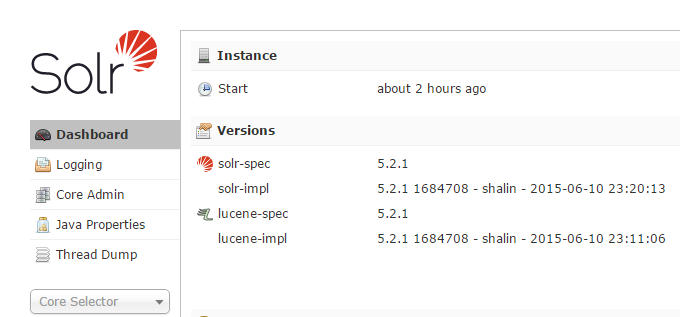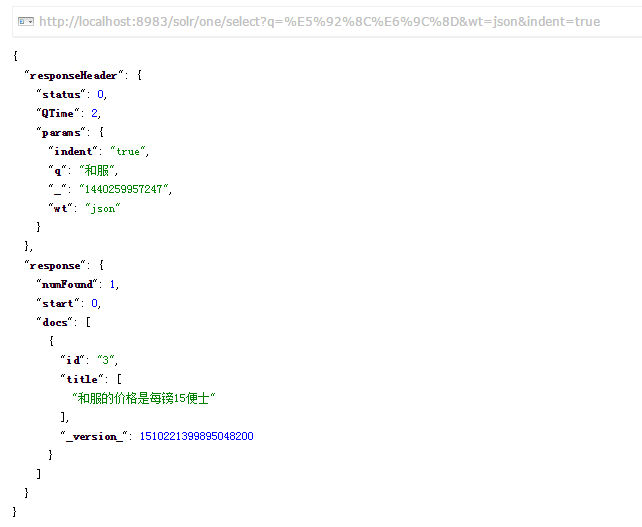以前发布过HanLP的Lucene插件,后来很多人跟我说其实Solr更流行(反正我是觉得既然Solr是Lucene的子项目,那么稍微改改配置就能支持Solr),于是就抽空做了个Solr插件出来,开源在Github上,欢迎改进。
HanLP中文分词solr插件支持Solr5.x,兼容Lucene5.x。

快速上手
-
将hanlp-portable.jar和hanlp-solr-plugin.jar共两个jar放入
${webapp}/WEB-INF/lib下 -
修改solr core的配置文件
${core}/conf/schema.xml:
<fieldType name="text_cn" class="solr.TextField"> <analyzer type="index"> <tokenizer class="com.hankcs.lucene.HanLPTokenizerFactory" enableIndexMode="true"/> </analyzer> <analyzer type="query"> <!-- 切记不要在query中开启index模式 --> <tokenizer class="com.hankcs.lucene.HanLPTokenizerFactory" enableIndexMode="false"/> </analyzer> </fieldType> <!-- 业务系统中需要分词的字段都需要指定type为text_cn --> <field name="my_field1" type="text_cn" indexed="true" stored="true"/> <field name="my_field2" type="text_cn" indexed="true" stored="true"/>
Solr5中文分词器详细配置
对于新手来说,上面的两步可能太简略了,不如看看下面的step by step。本教程使用Solr5.2.1,理论上兼容solr5.x。
放置jar
将上述两个jar放到solr-5.2.1/server/solr-webapp/webapp/WEB-INF/lib目录下。如果你想自定义词典等数据,将hanlp.properties放到solr-5.2.1/server/resources,该目录也是log4j.properties等配置文件的放置位置。HanLP文档一直在说“将配置文件放到resources目录下”,指的就是这个意思。作为Java程序员,这是基本常识。
启动solr
首先在solr-5.2.1\bin目录下启动solr:
solr start -f
用浏览器打开http://localhost:8983/solr/#/,看到如下页面说明一切正常:

创建core
在solr-5.2.1\server\solr下新建一个目录,取个名字比如叫one,将示例配置文件solr-5.2.1\server\solr\configsets\sample_techproducts_configs\conf拷贝过来,接着修改schema.xml中的默认域type,搜索
<fieldType name="text_general" class="solr.TextField" positionIncrementGap="100"> ... </fieldType>
替换为
<!-- 默认文本类型: 指定使用HanLP分词器,同时开启索引模式。 通过solr自带的停用词过滤器,使用"stopwords.txt"(默认空白)过滤。 在搜索的时候,还支持solr自带的同义词词典。--> <fieldType name="text_general" class="solr.TextField" positionIncrementGap="100"> <analyzer type="index"> <tokenizer class="com.hankcs.lucene.HanLPTokenizerFactory" enableIndexMode="true"/> <filter class="solr.StopFilterFactory" ignoreCase="true" words="stopwords.txt" /> <!-- 取消注释可以启用索引期间的同义词词典 <filter class="solr.SynonymFilterFactory" synonyms="index_synonyms.txt" ignoreCase="true" expand="false"/> --> <filter class="solr.LowerCaseFilterFactory"/> </analyzer> <analyzer type="query"> <tokenizer class="com.hankcs.lucene.HanLPTokenizerFactory" enableIndexMode="true"/> <filter class="solr.StopFilterFactory" ignoreCase="true" words="stopwords.txt" /> <filter class="solr.SynonymFilterFactory" synonyms="synonyms.txt" ignoreCase="true" expand="true"/> <filter class="solr.LowerCaseFilterFactory"/> </analyzer> </fieldType>
意思是默认文本字段类型启用HanLP分词器,text_general还开启了solr默认的各种filter。
solr允许为不同的字段指定不同的分词器,由于绝大部分字段都是text_general类型的,可以说这种做法比较适合新手。如果你是solr老手的话,你可能会更喜欢单独为不同的字段指定不同的分词器及其他配置。如果你的业务系统中有其他字段,比如location,summary之类,也需要一一指定其type="text_general"。切记,否则这些字段仍旧是solr默认分词器,会造成这些字段“搜索不到”。
另外,切记不要在query中开启indexMode,否则会影响PhaseQuery。indexMode只需在index中开启一遍即可,要不然它怎么叫indexMode呢。
如果你不需要solr提供的停用词、同义词等filter,如下配置可能更适合你:
<fieldType name="text_cn" class="solr.TextField"> <analyzer type="index"> <tokenizer class="com.hankcs.lucene.HanLPTokenizerFactory" enableIndexMode="true"/> </analyzer> <analyzer type="query"> <!-- 切记不要在query中开启index模式 --> <tokenizer class="com.hankcs.lucene.HanLPTokenizerFactory" enableIndexMode="false"/> </analyzer> </fieldType> <!-- 业务系统中需要分词的字段都需要指定type为text_cn --> <field name="my_field1" type="text_cn" indexed="true" stored="true"/> <field name="my_field2" type="text_cn" indexed="true" stored="true"/>
完成了之后在solr的管理界面导入这个core one:

接着就能在下拉列表中看到这个core了:

上传测试文档
修改好了,就可以拿一些测试文档来试试效果了。hanlp-solr-plugin代码库中的src/test/resources下有个测试文档集合documents.csv,其内容如下:
id,title 1,你好世界 2,商品和服务 3,和服的价格是每镑15便士 4,服务大众 5,hanlp工作正常
代表着id从1到5共五个文档,接下来复制solr-5.2.1\example\exampledocs下的上传工具post.jar到resources目录,利用如下命令行将数据导入:
java -Dc=one -Dtype=application/csv -jar post.jar *.csv
Windows用户的话直接双击该目录下的upload.cmd即可,Linux用户运行upload.sh。
正常情况下输出如下结果:
SimplePostTool version 5.0.0 Posting files to [base] url http://localhost:8983/solr/one/update using content- type application/csv... POSTing file documents.csv to [base] 1 files indexed. COMMITting Solr index changes to http://localhost:8983/solr/one/update... Time spent: 0:00:00.059 请按任意键继续. . .
同时刷新一下core one的Overview,的确看到了5篇文档:

搜索文档
是时候看看HanLP分词的效果了,点击左侧面板的Query,输入“和服”试试:

发现精确地查到了“和服的价格是每镑15便士”,而不是“商品和服务”这种错误文档:

这说明HanLP工作良好。
要知道,不少中文分词器眉毛胡子一把抓地命中“商品和服务”这种错误文档,降低了查准率,拉低了用户体验,跟原始的MySQL LIKE有何区别?
索引模式的功能
索引模式可以对长词进行全切分,得到其中蕴含的所有词汇。比如“中医药大学附属医院”在HanLP索引分词模式下的切分结果为:
中0 医1 药2 大3 学4 附5 属6 医7 院8 [0:3 1] 中医药/n [0:2 1] 中医/n [1:3 1] 医药/n [3:5 1] 大学/n [5:9 1] 附属医院/nt [5:7 1] 附属/vn [7:9 1] 医院/n
开启indexMode后,无论用户搜索“中医”“中医药”还是“医药”,都会搜索到“中医药大学附属医院”:

高级配置
目前本插件支持如下基于schema.xml的配置:
| 配置项名称 | 功能 | 默认值 |
|---|---|---|
| enableIndexMode | 设为索引模式 | true |
| enableCustomDictionary | 是否启用用户词典 | true |
| customDictionaryPath | 用户词典路径(绝对路径或程序可以读取的相对路径,多个词典用空格隔开) | null |
| stopWordDictionaryPath | 停用词词典路径 | null |
| enableNumberQuantifierRecognize | 是否启用数词和数量词识别 | true |
| enableNameRecognize | 开启人名识别 | true |
| enableTranslatedNameRecognize | 是否启用音译人名识别 | false |
| enableJapaneseNameRecognize | 是否启用日本人名识别 | false |
| enableOrganizationRecognize | 开启机构名识别 | false |
| enablePlaceRecognize | 开启地名识别 | false |
| enableNormalization | 是否执行字符正规化(繁体->简体,全角->半角,大写->小写) | false |
| enableTraditionalChineseMode | 开启精准繁体中文分词 | false |
对于更高级的配置,HanLP分词器主要通过class path下的hanlp.properties进行配置,请阅读HanLP自然语言处理包文档以了解更多相关配置,如:
-
停用词
-
用户词典
-
词性标注
-
……
代码调用
在Query改写的时候,可以利用HanLPAnalyzer分词结果中的词性等属性,如
String text = "中华人民共和国很辽阔";
for (int i = 0; i < text.length(); ++i)
{
System.out.print(text.charAt(i) + "" + i + " ");
}
System.out.println();
Analyzer analyzer = new HanLPAnalyzer();
TokenStream tokenStream = analyzer.tokenStream("field", text);
tokenStream.reset();
while (tokenStream.incrementToken())
{
CharTermAttribute attribute = tokenStream.getAttribute(CharTermAttribute.class);
// 偏移量
OffsetAttribute offsetAtt = tokenStream.getAttribute(OffsetAttribute.class);
// 距离
PositionIncrementAttribute positionAttr = kenStream.getAttribute(PositionIncrementAttribute.class);
// 词性
TypeAttribute typeAttr = tokenStream.getAttribute(TypeAttribute.class);
System.out.printf("[%d:%d %d] %s/%s\n", offsetAtt.startOffset(), offsetAtt.endOffset(), positionAttr.getPositionIncrement(), attribute, typeAttr.type());
}
在另一些场景,支持以自定义的分词器(比如开启了命名实体识别的分词器、繁体中文分词器、CRF分词器等)构造HanLPTokenizer,比如:
tokenizer = new HanLPTokenizer(HanLP.newSegment()
.enableJapaneseNameRecognize(true)
.enableIndexMode(true), null, false);
tokenizer.setReader(new StringReader("林志玲亮相网友:确定不是波多野结衣?"));
...
反馈
技术问题请在Github上发issue 
反馈问题的时候请一定附上版本号、触发代码、输入输出,否则无法处理。
版权
Apache License Version 2.0
 码农场
码农场